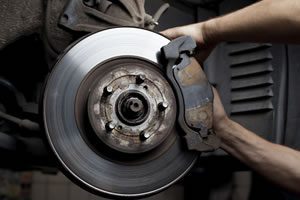 - Client Reviews
- Client Reviews In the 1800’s, the first mechanisms to slow a vehicles momentum and prevent motion were tested. Today, over 100 years later, the braking system has evolved into a complex device designed to adapt to different road conditions. From the early drum brakes to modern day discs, brake system evolution has improved safety and reduced the risk of car crashes across Canada and the globe.
In the 1800’s, the first mechanisms to slow a vehicles momentum and prevent motion were tested. Today, over 100 years later, the braking system has evolved into a complex device designed to adapt to different road conditions. From the early drum brakes to modern day discs, brake system evolution has improved safety and reduced the risk of car crashes across Canada and the globe.
With so many forms of brakes that have existed over the century, it is hard to pinpoint the inventor of the original brake system; however, those who designed these systems had a common goal: to make it possible for humans to control a motor vehicle. With the goal of creating safer conditions, innovators over the years have brought new technologies to the braking system, improving upon this original idea.
If you or someone you love was involved in an auto accident because of another drivers negligence, you may be eligible to pursue compensation for your losses. The lawyers of Greg Monforton and Partners believe the parties responsible for a persons injuries and suffering should be held accountable for their negligent acts. We passionately defend the rights of accident victims in Windsor and throughout Ontario.
Find out how we can help fill out the FREE Case Evaluation form to the right to get started now. Its 100% Confidential.
The Development of the Braking System
The evolution of brakes has been impressive, and has included many new technologies throughout the years. In all new developments to the brake system, the number one priority is to improve auto safety and efficiency.
Since the earliest automobiles, several methods of braking have been used. As the history of brakes progressed, each new system was built using the concepts used to design its predecessor.
Brake system evolution began in the 19th century, and continues today. The types of braking systems that have been used over the years include:
- Wooden block brakes
The earliest brake system applied the physical principles used to design brakes today; however, the system consisted only of wooden blocks and a single lever used by the driver to apply the brake. This form was used on vehicles with steel-rimmed wheels, including horse-drawn vehicles and steam-driven automobiles.
- Mechanical drum brakes
Considered to be the foundation of the modern braking system, the mechanical drum brake was developed in 1902 by French manufacturer Louis Renault, but had been invented earlier by Gottlieb Daimler. Daimler had theorized that anchoring a cable-wrapped drum to the vehicles chassis could be used to stop momentum, thus creating the first concept of the drum brake.
- Expanding internal shoe brakes
Before the expanding internal shoe brake was invented, all brake systems had been fastened outside of the vehicle. Those systems were vulnerable to the elements, collecting dust and water, and being affected by fluctuations in temperature all of which made the brake less effective. The internal shoe brake was the first to be fixed inside the vehicles frame, an important innovation in the history of braking systems.
- Hydraulic brakes
In 1918, the concept of a four-wheel brake system using hydraulics was first proposed by Malcolm Loughead. The system used fluids to transfer force to the brake shoe when a pedal was pressed. This braking system was adopted in nearly every vehicle by the late 1920’s.
- Disc brakes
The disc brake was invented long before becoming popular. William Lanchester patented the disc brake in 1902; the system was not popular until the auto industry began to boom in the mid-20th century. The rise of disc brakes as a popular option is attributed to the increasing weight and speed capabilities of vehicles, which caused hydraulic brakes to become less efficient in distributing heat. The first system to use disc brakes integrated both disc and hydraulic functions and was introduced in the Chrysler Imperial.
- Anti-lock brakes
The anti-lock brake system, better known as ABS, was created to assist previous braking systems to prevent the brakes from locking up while in use. ABS works by sensing when a lock is about to occur and igniting a system of hydraulic valves to reduce the pressure of a brake on a single wheel. The system revolutionized the way brakes function and is useful in providing more control for the modern driver.
Hurt In A Crash? Contact Us Today
Brake system evolution has seen interesting advances in technology since the introduction of the wooden block brake. Such innovations have led to an increase in safety on the road and fewer accidents.
Unfortunately, brakes can still fail, and car crashes are not always avoidable. When another drivers negligence causes a car accident, the legal team at Greg Monforton and Partners believes that motorist should be held accountable for their actions. If you have been seriously injured or lost a loved one in a motor vehicle collision, you may be eligible for compensation in a personal injury or wrongful death case.
We are proud to serve the citizens of Windsor and all of Ontario, and accept clients from the following areas:
- LaSalle
- Emeryville
- Lakeshore
- Leamington
- Wheatley
- Tilbury
- and communities throughout Ontario
Call (866) 320-4770 today to discuss your case confidentially with our legal professionals. We can analyze the details surrounding your claim and determine whether you have a case for free.
Get started now Fill out the Free Case Evaluation form at the top of this page to begin your free consultation.

